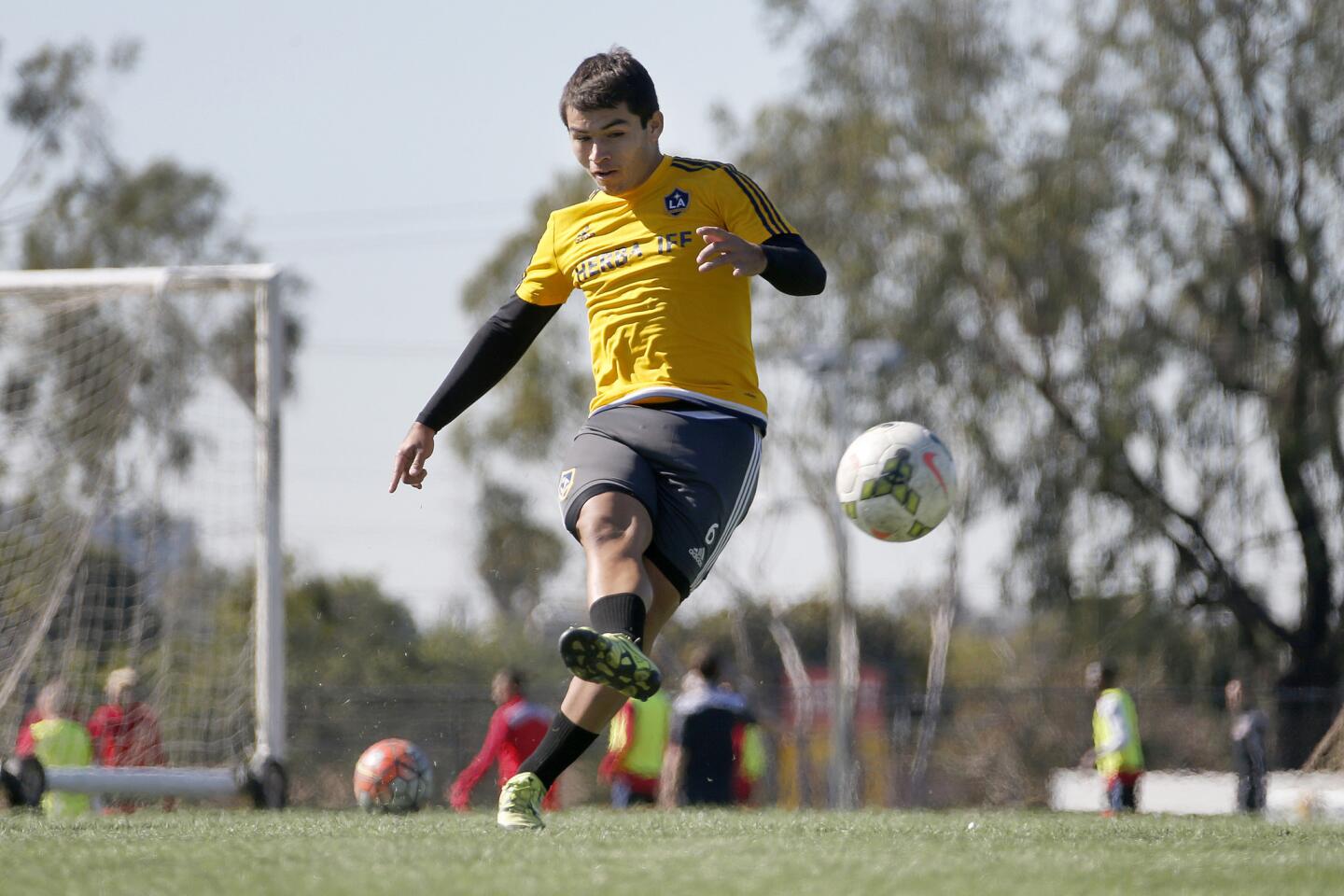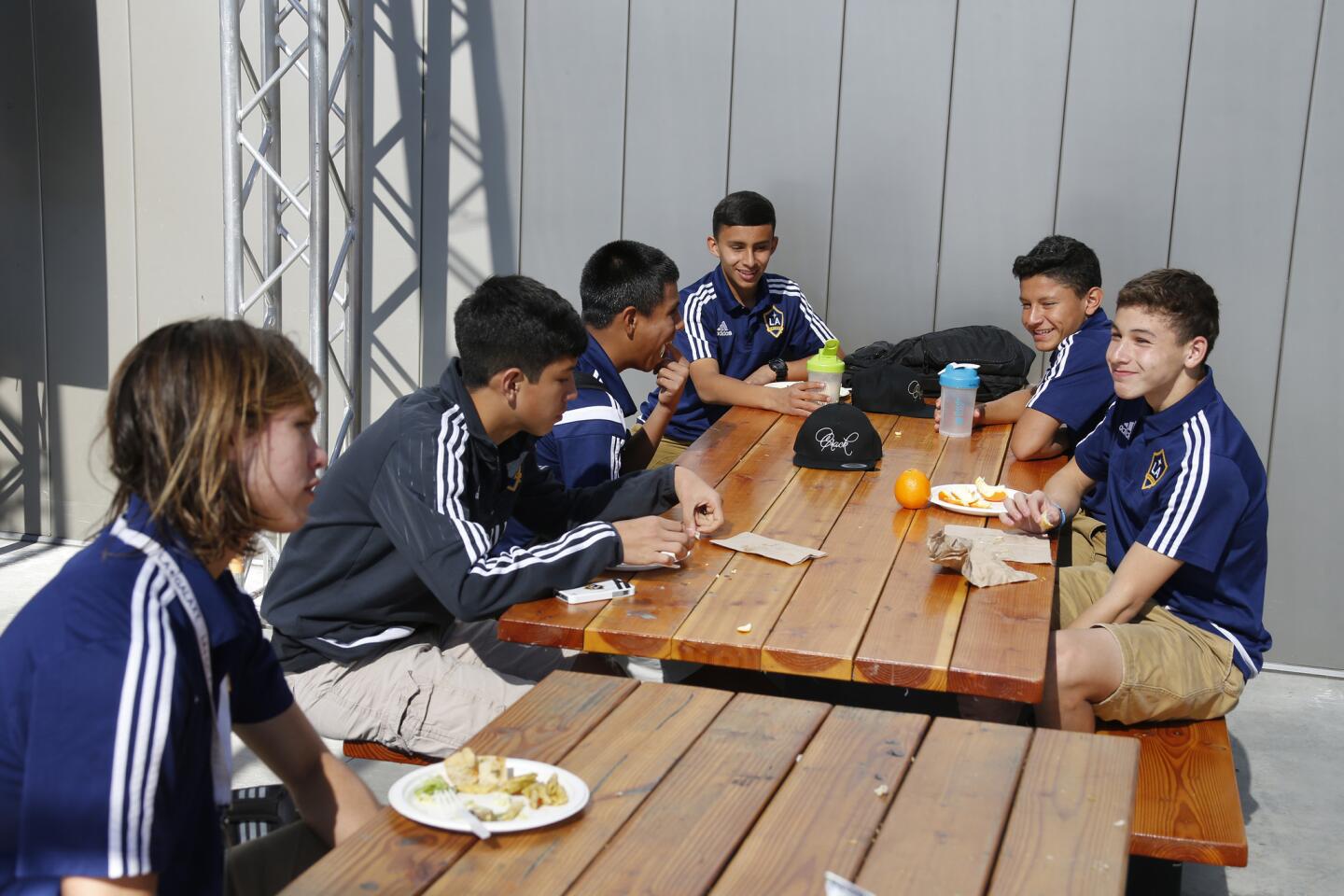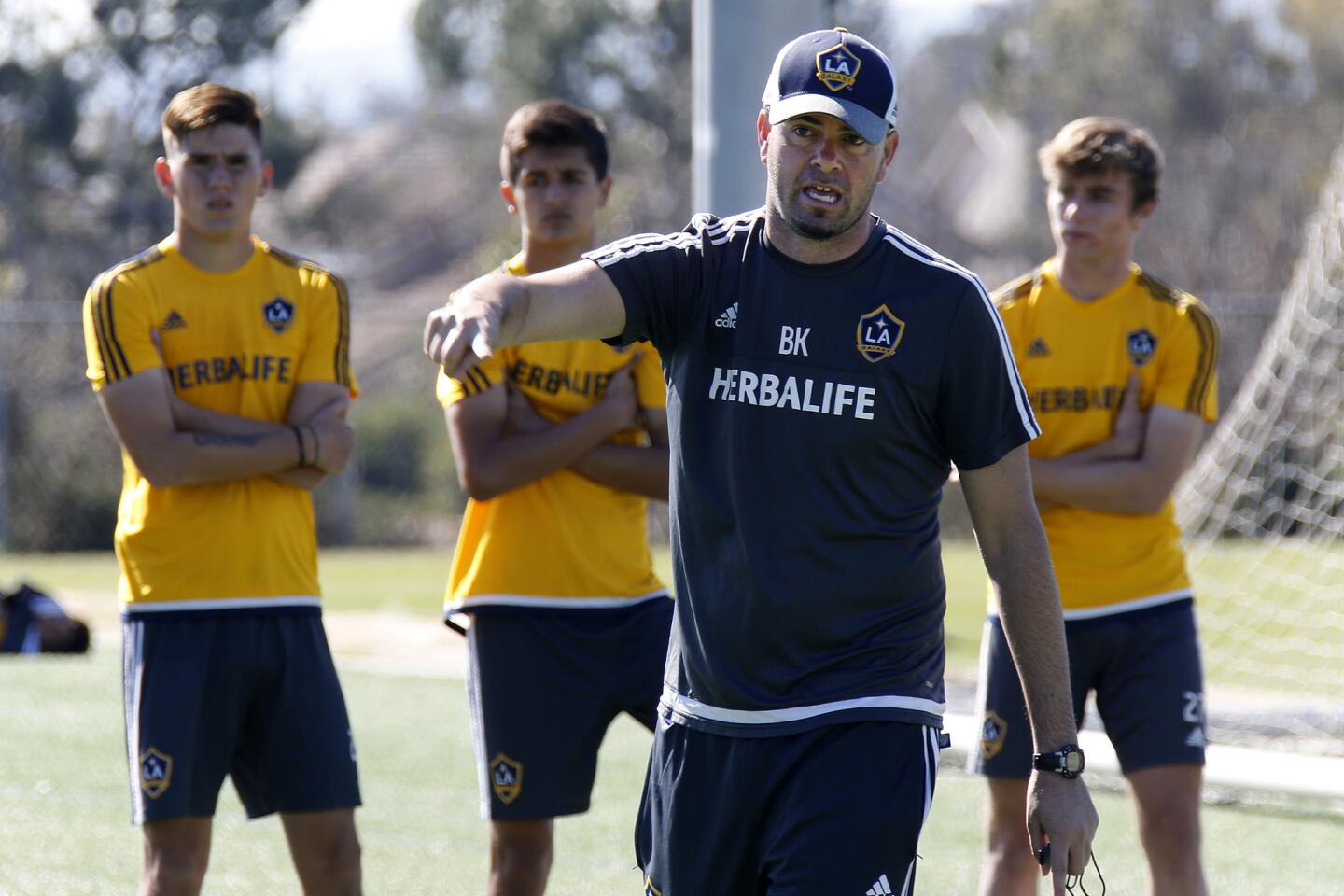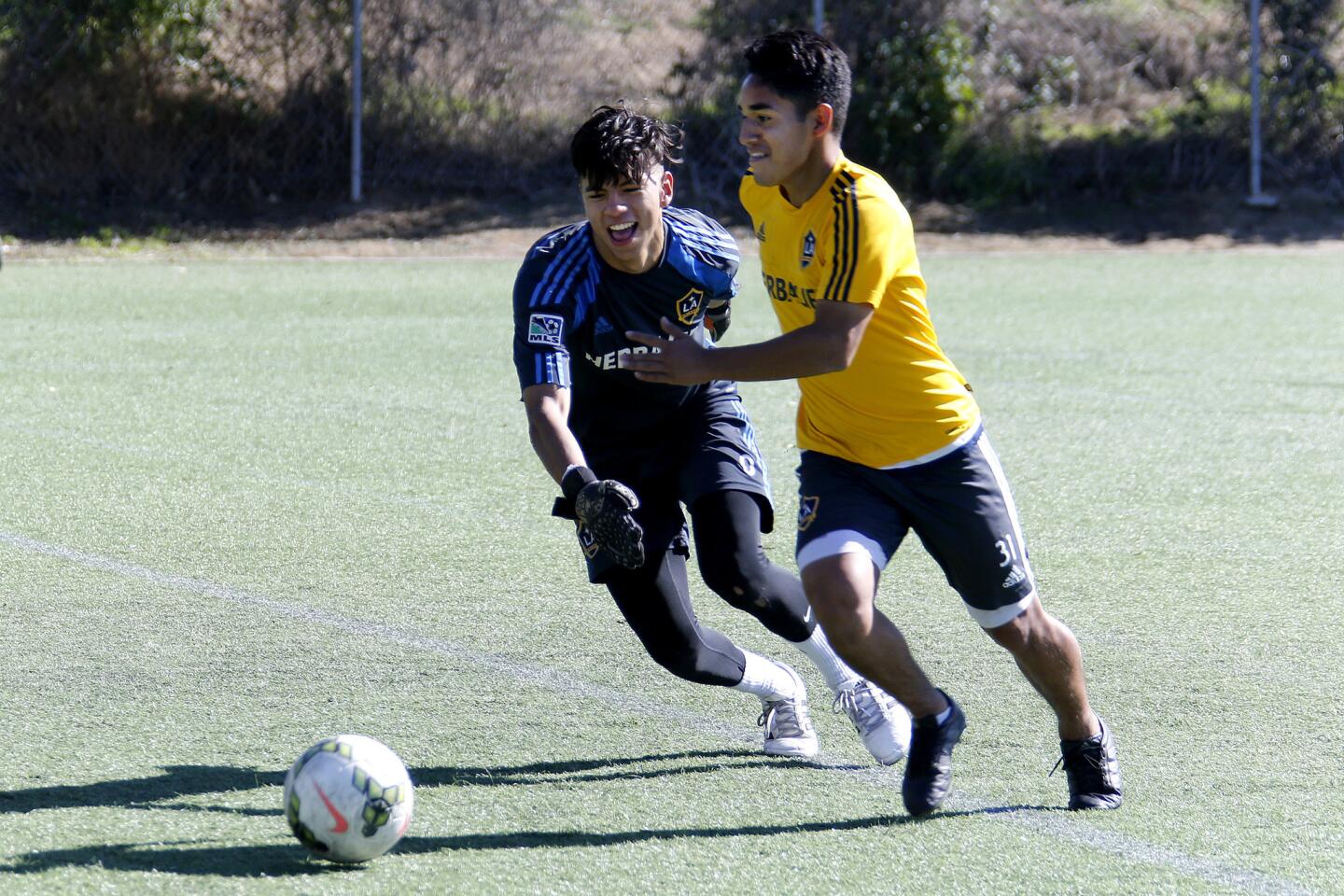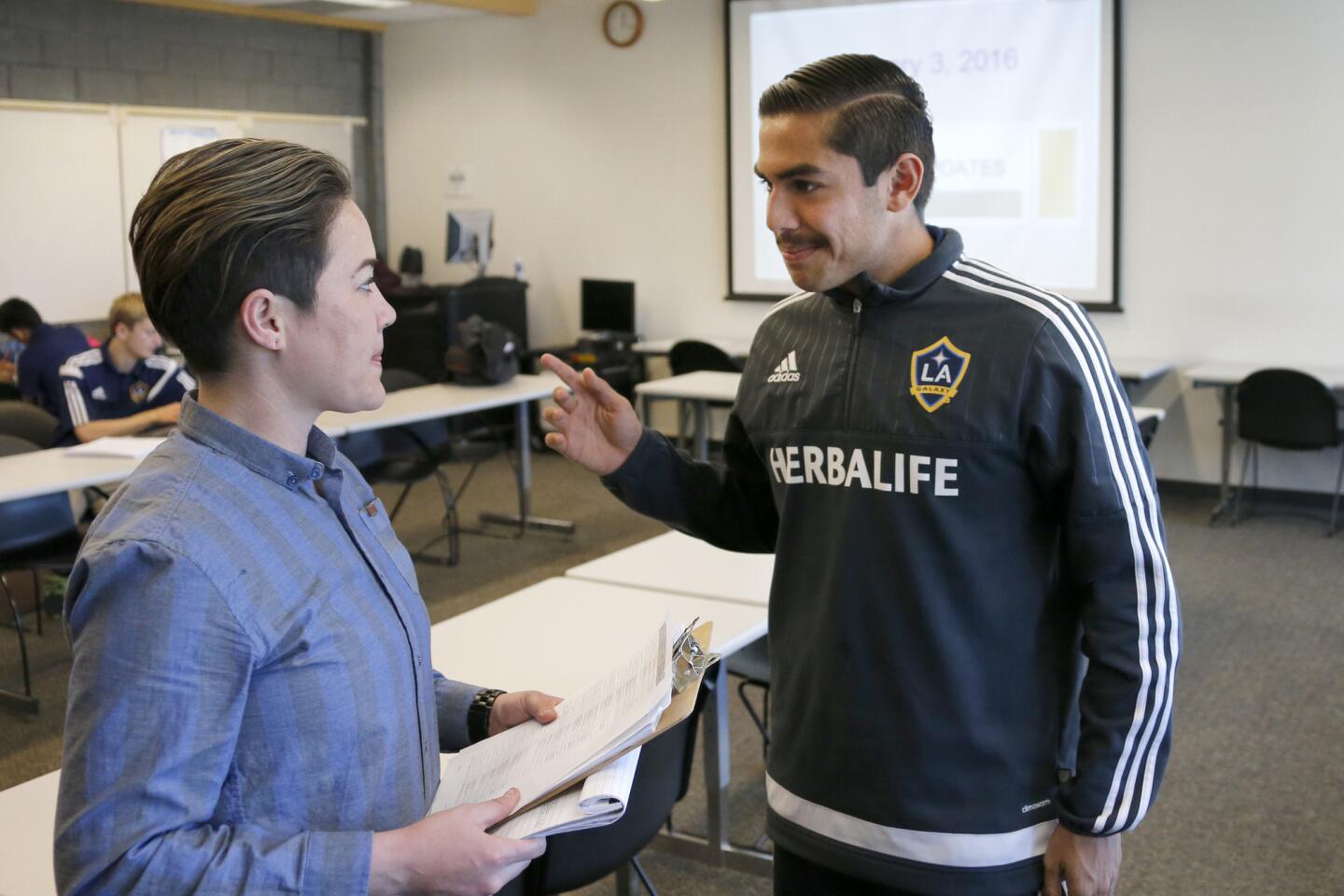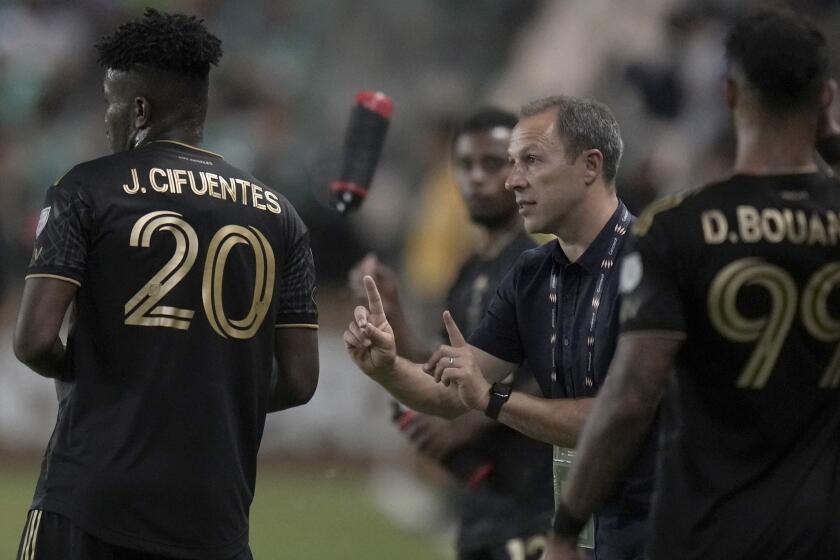At the Galaxy’s school, soccer is hardly the only subject
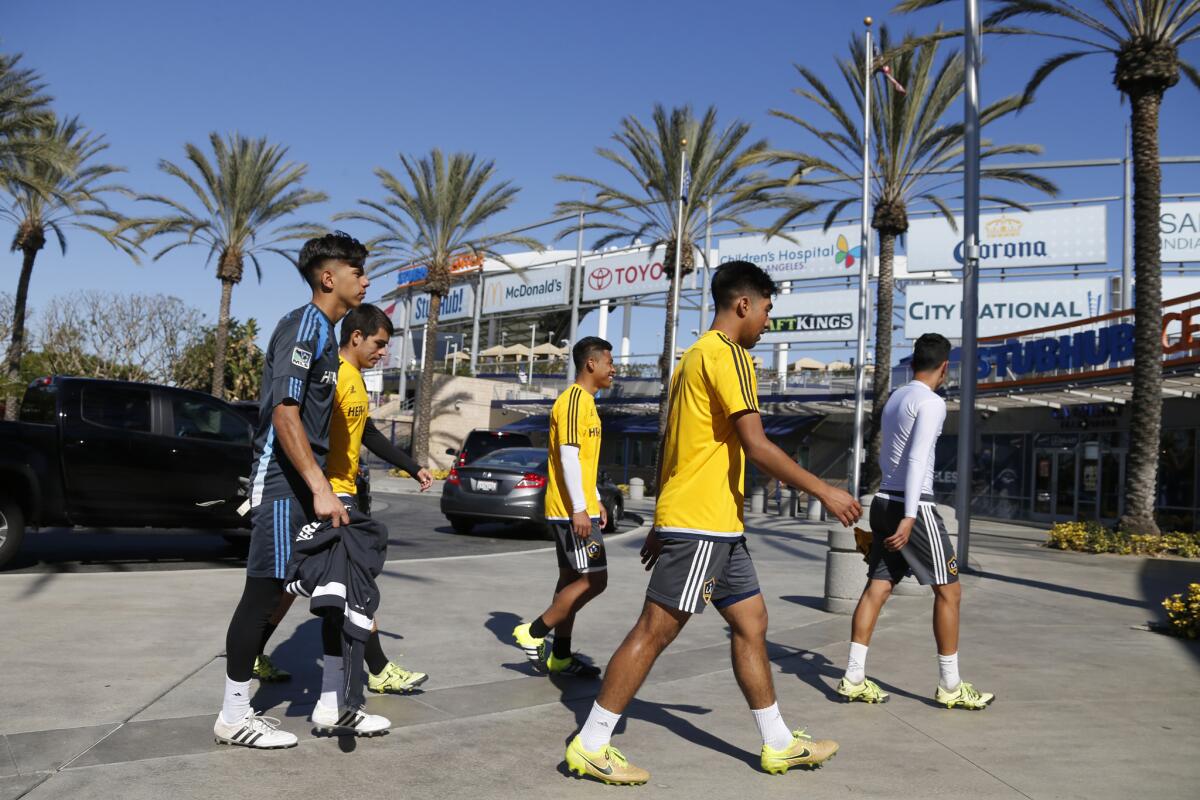
LA Galaxy Youth Academy athletes walk to lunch together after practice at the StubHub Center.
- Share via
Midfielder Paolo Carrillo-Weisenburger played one game of school soccer, in the seventh grade, and finished with two goals and an assist. It was an experience, the 15-year-old remembers, that taught him two things: He was pretty good and interscholastic soccer wasn’t.
“I knew that level of play wasn’t going to help me get better,” he said. “I wanted to put myself in a challenging environment.”
The high school sophomore found that with the Galaxy, as one of 150 kids between ages 12 and 18 good enough to earn a spot on one of the team’s seven youth academy squads.
But he took an even bigger step toward finding out how good he could be a few months ago when he was one of 50 blue-chip players enrolled in the Galaxy’s first full-time school, a program that mixes high school studies with elite soccer training at the StubHub Center.
“It is unique and it is the first of its kind,” said Pete Vagenas, director of the Galaxy’s academy system. “You do want to empower these kids and you want to encourage them to take hold of not only their career, but their education.”
For the Galaxy, the benefits are obvious since developing their own players can be far cheaper than acquiring them. The team spends about $4 million annually on player development, including the school and academy programs, about $2 million less than it will pay veteran midfielder Steven Gerrard this season.
In addition, Vagenas says the biggest growth spurt for young soccer players takes place around their freshman year. So by enrolling players in the team’s school, the Galaxy can work with them for nearly nine hours each weekday — training, educating and feeding them — before turning them back to parents each night without worrying about losing them to a school program or one of the many elite youth soccer programs in Southern California.
“If you start peeling back the layers, we can improve the way we go about our business. Going forward, it is in our interest to make sure that we develop players versus always acquiring them,” Vagenas said.
It’s a model that’s been successful for soccer clubs around the world — and one that’s now beginning to take hold in the U.S. Last June, Major League Soccer’s Philadelphia Union saw the first class graduate from its 3-year-old college-preparatory school, which is housed across the street from the team’s youth development academy. And Real Salt Lake plans to build a $50-million complex for both its first team and its academy players, who will attend classes at a charter school affiliated with Utah State University.
The Galaxy will present their first senior class of 11 students with high school diplomas in June.
This could change how we develop players in this country. And the hope is a Lionel Messi or a Cristiano Ronaldo will come from the United States.
— Galaxy President Chris Klein
“We think this is a big shift in culture,” said Galaxy President Chris Klein, whose academy program was already the envy of Major League Soccer, having produced six players on the team’s current first-team roster. “Establishing academies is a big shift. Then investing in it and building out the environment is the next step.
“This could change how we develop players in this country. And the hope is a Lionel Messi or a Cristiano Ronaldo will come from the United States.”
Messi graduated from Barcelona’s famed La Masia academy, and Ronaldo trained at an academy run by Portugal’s Sporting C.P. What makes the Galaxy’s school program different, though, is that everything happens at one place, with twice-daily training sessions sandwiched around four hours of studies in a Cal State Dominguez Hills classroom a few hundred yards away from the Galaxy’s locker room. Before the academic component was added last fall, the Galaxy’s youth players typically attended their neighborhood schools, then negotiated afternoon traffic to get to and from the StubHub Center for soccer training.
“These kids show up every day, they train in a professional environment, they go to school and they’re able to get home at a reasonable hour,” Vagenas said of the new school program. “In the previous model, kids and parents spent whole afternoons driving to and from practice. They would end up eating in the car. Kids now are done [for the day] at a consistent time.”
The curricula, in core subjects such as math, science, history and language arts, are developed by California Connections Academy, an accredited online school. The Galaxy school’s students work independently on laptops, completing up to five lessons a day; they also meet regularly with tutors and academic advisors.
The Galaxy cover all costs, including tuition, computers and meals, for the 50 students.
Stefanie Baduria, a former college soccer player and fourth-grade teacher, is responsible for uniting athletics and academics. And she said she’s had success convincing students that the two go hand-in-hand.
“It’s a constant conversation, equating what they do in the classroom to what they do in the field,” she said. “And also reminding them … the Galaxy has standards of excellence that they now need to live up to. So if they’re doing an algebra lesson and we see that they are not taking notes or not trying, it’s ‘Well, on the field would you never practice your [penalty kicks] before the actual PK shootout?’
“They take to it.”
Graduation from the program doesn’t guarantee a player promotion to the next level, which in the Galaxy’s case is Galaxy II, the team’s farm club in the third-tier, pro United Soccer League. A spokesman said the Galaxy hasn’t decided if they will sign anyone from this summer’s class, meaning most will move on to major college programs.
Baduria said that’s a part of the discussion with players as well.
“We are realistic with our kids,” she said. “We don’t think that all 50 are going to end up playing professionally. So our goal for them is, after they graduate with us, they will be going to a [Division I] school and playing college soccer.
“But I have to argue for the side of what we’re doing. The kids having the work on their laptops gives them the flexibility their lifestyle as an elite soccer player needs. In traditional schooling, if they were with the [U.S. junior] national team for two weeks, they’re behind two weeks when they come back.
“With us they bring their laptop. They don’t fall behind.”
This school term, the Galaxy had 18 players spend time with age-group national teams. Among them was 13-year-old Efrain Alvarez, one of the school’s three eighth-graders, who scored four goals and had two assists to help the U.S. win an international tournament in Argentina this spring.
There are sacrifices, though: no school dances, no proms and no yearbooks.
“I miss the social life,” conceded Tristan Weber, who attended San Clemente High last year. “But … the dream is to become a professional soccer player. This is what I’ve got to do if I want to go far in soccer.”
Vagenas, the captain of the Galaxy’s 2005 MLS Cup champions, fights the urge to wince when he hears remarks like those. He excelled in both soccer and schooling under a tradition model, attending St. Francis, a private boys school in La Cañada-Flintridge, and later UCLA before being drafted by the Galaxy in 2000. Now he wonders what path he would prefer his 8-year-old son take: the one Vagenas followed or the one he urges other kids to take with the Galaxy?
“It is something that I thought about probably every single day on my drive home,” Vagenas said. “It was an environment that I aimed for, to be able to say that I would be able to [take] my own son and feel comfortable putting him in this type of environment.
Galaxy assistant coach Curt Onalfo already made his decision, enrolling his son Christian in the team’s school. He’ll be among the first graduates this summer and could go on to play for his father with Galaxy II, leaving him one step shy of MLS.
“I’m hesitant to identify one way that is best for everyone,” Vagenas continues. “[But] the model that we have here, I can say with 100% certainty, is the best way to progress into the L.A. Galaxy first team.”
Update: An earlier version of the story incorrectly said that the Galaxy school’s educational core subjects are developed by California Connections. In fact, the accredited online school is California Connections Academy.


